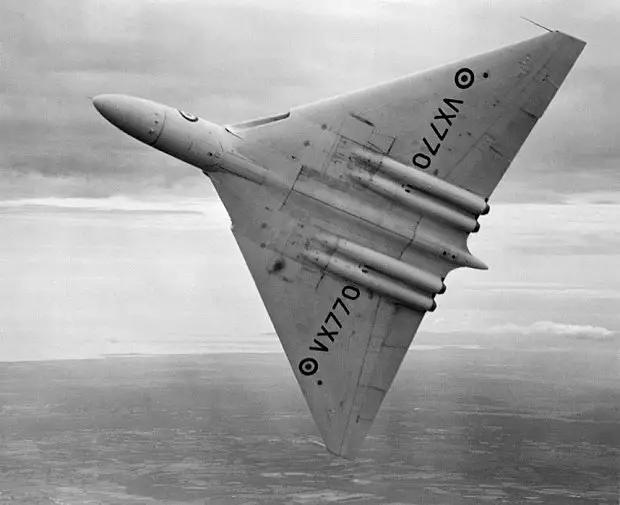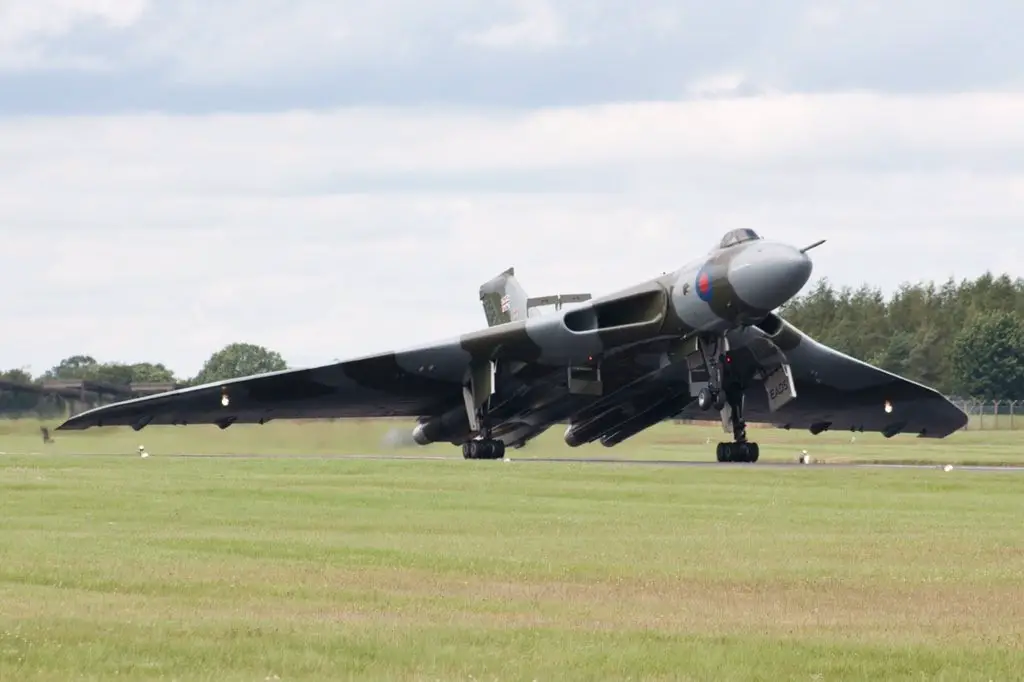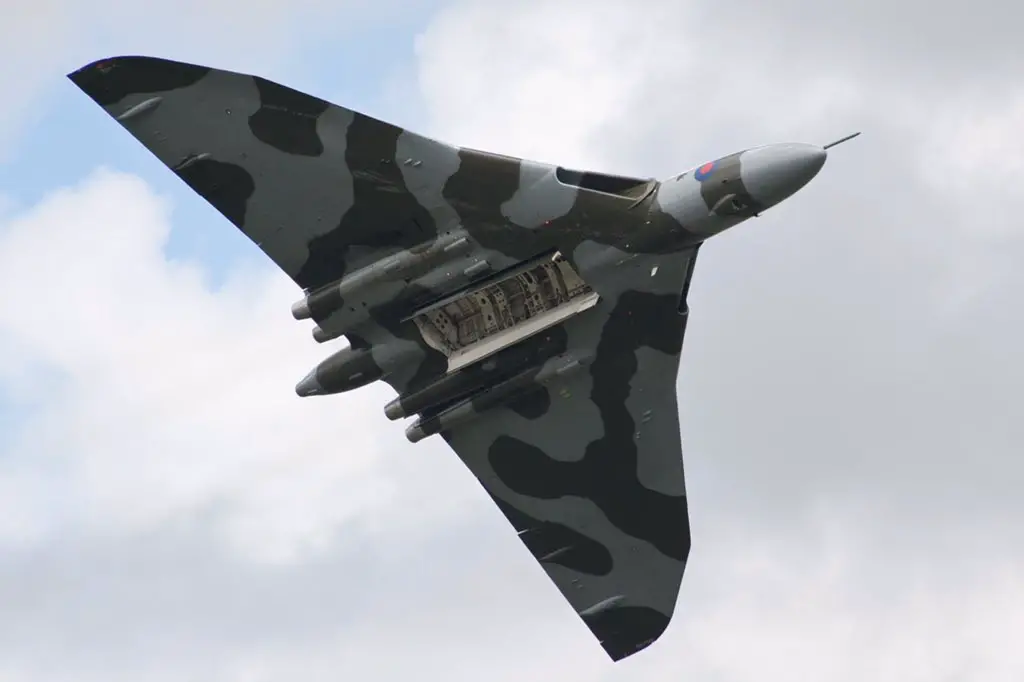Even the name was over the hill: Avro, the company named for dawn-of-flight founder A.V. Roe, went the way of one firm after another: merged into a soulless, nationalized conglomerate in a series of Socialist-policy forced consolidations of the British aircraft industry. In the end, they wound up sending British aero engineering talent to Canada, and Canadian bungling (with the Canadian Avro company front and center) banked them off and down to the United States, where they were critical to the success of Apollo. The Avro Vulcan was the last of the line that began with spindly triplanes of bamboo and muslin and that rained terror and death from the night skies over Germany.
“If a single bomber gets through,” boasted Hermann Göring, today dismissed as a buffoon but a leading World War I ace, “you can call me Meier!” And a single bomber didn’t get through, but hundreds, and then a thousand — Handley-Pages and Vickers and, chief among them, Avros, every night the weather enabled flying, and some nights it really didn’t, and by day the Americans gave the repair crews and fire brigades no rest.
In the late 1940s, Britain was a nuclear power, and it had one of the world’s most powerful navies and a first-class air force. The British nuclear deterrent originally comprised a fleet of bombers, and for this purpose, three new airframes were designed, the “V-bombers,” the name redolent of V-E Day and referring to the plane’s names. Three airframes were chosen because the performance demands were so high that some of the engineering teams were taking great risks. One jet was a very conservative design (the Vickers Valiant), in case of failure of the two using radical wing planforms: the sickle-shaped “crescent wing” Handley Page Victor and the delta-winged Avro Vulcan. All three planes succeeded, but the performance of the Victor and Vulcan ensured a short life for the Valiant.

Vulcan VX770 was the prototype Vulcan Mk 1 and was nearly a textbook-true delta wing. It was destroyed in an airshow crash in 1958. Early Vulcans were painted gloss “anti-flash” white in anticipation of a nuclear bombing role.
The Vulcan would serve 30 years; unlike the Victor, it was adaptable to a low-level conventional bombing mission, thanks to the excessive strength of its thick wings (the Victors were converted to the tanker role and had nearly as long a career).
As a nuclear bomber, the Vulcan never saw combat, but in the twilight of its service two Vulcans conducted raids on the Port Stanley airfield that closed the field to modern jets. At the time, they were the longest bombing raids in world history. (they were refueled, in part, by Victors).
Then, the jets retired and the roar of their loud, inefficient turbojets was heard no more. Britain’s nuclear deterrent was under the sea, in submarines. (Land-based ballistic missile designs all went the way of most post-war British defense inventions: budgetary cancellation). Nap-of-the-earth raids could be delivered by Typhoons.
But you can’t keep a good jet down — as long as there are three critical resources: trained pilots to fly it, experienced mechanics to fix it, and parts, or producers willing to make them. And, buoyed by funds from the National Lottery and thousands of small donors, and organized by a special charitable trust established for the purpose, the Vulcan returned, first to taxi (a peculiarly British way of displaying vintage aircraft with reduced risk) and then, triumphantly, to the air. (Indeed, two other Vulcans conduct taxi runs in the summer, XL426 and XM655).
Alas, one of those critical resources is running out and Vulcan XH558 is shown, here, landing for the last time.
Organisers had kept details of the final flight secret until the last minute over fears that dangerously large crowds would throng the airport for one last chance to see the aircraft.
A final nationwide tour held earlier this month was nearly cancelled over police concerns an influx of thousands of enthusiasts turning up at once would effectively shut down the small airport.Hundreds of thousands are believed to have glimpsed Vulcan XH558 as it spent two days doing flypasts around the country a fortnight ago.
Martin Withers, who led the 1982 Vulcan raids on the Falklands, was the pilot for the final flight.
As he prepared, he said: “Everyone asks me what is so special about this aircraft and why people love it. Really the people who fly it are the wrong people to ask. It’s such a combination of grace and beauty of just seeing this thing fly.”
“Just to see it fly along, it’s so graceful. And then that combines with the sense of power and manoeuvrability you’ve got with this aircraft and the vibrations it makes. It just seems to turn people on emotionally, they really love it.”
Former pilot Angus Laird added: “I think it’s very, very sad but we all come to a time when we stop flying. She’s an old lady now and she’s stopped at the height of her popularity, which I think is brilliant.”
via Video: Vulcan bomber touches down forever after final flight – Telegraph.
The resource that ran out wasn’t guys like Martin and Angus, who could have readily transmitted their skills and tribal knowledge to a new generation of pilots. (After all, the Shuttleworth Collection flies an Avro Triplane from circa 1909). The problem was the greying of the cadre of maintainers. These unsung “erks,” (aircraftsmen, the bottom rung of mechanic in the RAF), the “fitters” and “riggers” in British terms (powerplant and airframe mechanics respectively, in American), are the last repository of a vast corpus of tribal knowledge, call it Vulcana, perhaps, or Vulcanology. As each one passes away or becomes too infirm to work on this old dowager, vital links in the neural network of Vulcan lore and expertise disappear forever.
Nobody thought it was dangerous to fly XH558 now — well, no more dangerous than flying any other jet warplane approaching a human’s retirement age. But there was a consensus that flying her was going to get more hazardous soon.
The roar isn’t still, though — not yet. Next year’s airshow season, she’ll be doing high-speed taxiing at her home base. And XL426 and XM655 will be taxiing again next year, too.
Pity no one thought of doing this with the B-47, B-58, or the FB-111.

Kevin was a former Special Forces weapons man (MOS 18B, before the 18 series, 11B with Skill Qualification Indicator of S). His focus was on weapons: their history, effects and employment. He started WeaponsMan.com in 2011 and operated it until he passed away in 2017. His work is being preserved here at the request of his family.



18 thoughts on “Ave atque Vale: Flying Avro Vulcan”
https://weaponsman.com/?p=23718
Godspeed, prettybird.
…when a screech of brakes indicated the
arrival of a Lieutenant Commander, USN
(by his accent, he was a Texan). “What’s
the danged Piper Cub on the end there,
boy?” was demanded of me. “Well, sir, it’s
an Avro Type 693 Vulcan B.2 strategic
bomber, capable of high subsonic speed
at a ceiling
in excess of 60,000 ft; extremely
manoeuverable, cleared down to a ‘war
height’ of 300 ft agl, able to carry free-fall
or stand-off nuclear weapons, or 21,000
lbs of ‘iron’ bombs, and full ECM and
ECCM suites”.
Suitably impressed, he said “Gawd,
boy! You just phasin’ em in?” “No sir,
actually, we’re just starting to phase them
out.”
from http://m.dailykos.com/
story/2012/12/21/1170929/-The-god-of-
fire-the-Avro-Vulcan
What a great looking airplane. There’s one at the former Castle AFB (along with many other aircraft; it’s a great museum) if you’re ever unfortunate enough to find yourself temporarily among the Caliban.
When I was in language school we did a trip there — it was still an active AFB, but they were already building a museum collection. We got to try the B-52 gun simulator. (Even then the tail guns were out or on the way out).
His vices, gluttony, pride and his reputed morphine addiction did him no help. Once he got sober and lost weight in his Nürnberg cell, he became much more formidable. Made several prosecutors look very incompetent and put up a spirited defense.
Iirc the Valiants had a corrosion problem that saw them withdrawn early as rebuilding them was deemed too expensive.
A handful of Vulcans also served as tankers and maritime patrol aircraft, as K.2 and B.2 (MMR) versions respectively.
Shame, a long range bomber would still be useful for the RAF.
and remember:
don’t ever mention them canberras
A very, very rare example of a foreign plane so good the USAF couldn’t avoid buying it.
***and remember:
don’t ever mention them canberras***
AKA *Cranberries* So far as CAS went they had a REALLY LONG loiter time.
In 1987 on a trip home to England, my wife and I visited the museum at Manston in Kent. I had been there with my Dad in 1974 and wanted to wander down memory lane.
My wife was tired after the museum and wanted to lay down in the car for a few minutes, so I took the camera and wandered onto to back of the RAF base. About 400 metres up a gravel road were five Vulcans, two Victors and a couple of old twin engine transports. The area was being used to practice firefighting by the base EmerServ. One of the Valiants was 80% burned up and the second had gaping cuts in the fuselage. The Vulcans were all intact but on their bellies and one was placed so the nose was over a small drainage ditch with the crew hatch accessible. Figuring it was easier to ask forgiveness than permission, I clambered up the bay to the cockpit. It was totally stripped but was nonetheless a tremendous experience to be in such a sacred place. I took many photos and still regret not waking my wife to get an I was here snapshot. I tried a timer shot but didn’t have anything to place the camera on properly. Probably one of the most satisfying but also melancholy airplane photo sessions I’ve ever had.
Oddly for an active service base no one came near where I was until after I had gotten back to my car.
Truly a golden age aircraft from the days of “If it looks good, it’ll fly good”!
If you go to youtube and do a search for Vulcan Beachy Head there are some fantastic videos of one of the last few flights from a great vantage point.
Vulcan also shares the base engine with Concorde
Ah, from the days we Yanks used to look at British aircraft and say, “How did those guys on that little island do that!” (Blackburn Buccaneer is another one of those).
Thanks for the tip!
I think we were quite partial to Mustangs and Phantoms though!
The Vulcan on display at the SAC Museum is quite impressive. I wasn’t here when it made its flight in but everyone said it put on quite the show. I don’t think the RAF maintain anything in the long-range bomber class any more but feel free to correct me.
Closest I ever got to a Vulcan was watching the James Bond flick Thunderball [the first one, with Samantha Auger, not *Never say Never again, not ever never* in which a Vulcan mockup does a water ditching. Though they blew up the mockups to keep them from turning up in any future movie productions, the remains of the two mockups are said to be a popular commercial dive site in the Bahamas.
http://shipofdreams.me.uk/pinewood/images/vulcan2_lge-adj.jpg
I was extremely fortunate to see one of the last flights of the Vulcan at the Portrush Airwaves air show there at the start of September. Despite a spectacular roster of aircraft ( including Spitfire, Hurricane, B-17G Flying Fortress, Saab Viggen, and Typhoon GR4 ) the Vulcan was probably the most poignant to watch. And oh boy was it loud. The wife hadn’t heard of the Vulcan before, or the Falklands bombing raid and wasn’t sure why I was excited to see it fly, but she understood after. There’s just something about the shape, that unmistakable silhouette and the grace with which it flew. I reckon I was pretty lucky to experience it. They don’t make em like that any more.
Saw one close-up doing flyovers at a corporate families-only airshow in the late 80’s or early 90s.
Truly one of the most beautiful and graceful aircraft ever made.